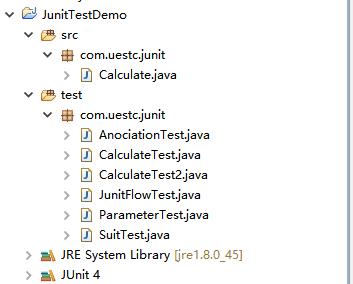最近项目中需要用到junit单元测试,就在慕课网进行了学习,老师讲的很清晰,适合入门。
1.代码结构

2.JUnit简单测试
1.被测试类
public class Calculate { public int add(int a, int b) { return a + b; } public int subtract(int a, int b) { return a - b; } public int multiply(int a, int b) { return a * b; } public int divide(int a, int b) { return a / b; } }
测试类与测试方法
import static org.junit.Assert.*; import org.junit.Test; public class CalculateTest2 { /* * 1.测试方法上必须使用@Test进行修饰 * 2.测试方法必须使用public void 进行修饰,并且不带参数 * 3.新建一个源代码目录存放测试代码,命名为test * 4.测试类的包应和被测试类的包保持一致 * 5.测试单元中的每个方法必须可以独立测试,测试方法间不能有任何的依赖 * 6.测试类建议使用Test作为类名的后缀,测试方法建议使用test作为方法名的前缀。 */ /* * 1.Failures一般由测试使用的断言方法判断失败引起的,表示测试点发现了问题,程序输出的结果与我们预期不一样。 * 2.Error是由代码异常引起的,它可以产生于测试代码本身的错误,也可以是被测试代码中的一个隐藏bug。 * 3.测试用例不是证明你是对的,而是用来证明你没有错,对程序员的逻辑错误无能为力。 */ @Test public void testAdd() { assertEquals(5, new Calculate().add(2, 3)); } @Test public void testSubtract() { assertEquals(3, new Calculate().subtract(7, 4)); } @Test public void testMultiply() { assertEquals(8, new Calculate().multiply(2, 4)); } @Test public void testDivide() { assertEquals(9, new Calculate().divide(18, 2)); } }
3.JUnit常用注解
import static org.junit.Assert.*; import org.junit.Ignore; import org.junit.Test; public class AnociationTest { /* * @Test:将一个普通方法修饰为一个测试方法 * @Test(expected=XX.class) * @Test(timeout=XXms) 超过时间即停止运行,并表明测试不成功。 * @BeforeClass:它会在所有的方法运行前被执行,static修饰 * @AfterClass:它会在所有的方法运行后被执行,static修饰 * @Before:它会在每个测试方法运行前被执行一次 * @After:它会在每个测试方法运行后被执行一次 * @Ignore:它修饰的测试方法会被测试运行器忽略,不被执行。 * @RunWith:可以更改测试运行器,定制个人运行器,继承org.junit.Runner */ @Test(expected=ArithmeticException.class) public void testDivide(){ assertEquals(2, new Calculate().divide(3, 0)); } @Ignore @Test(timeout=2000) public void testWhile() { while(true){ System.out.println("run forever..."); } } @Test(timeout = 3000) public void testReadFile(){ try { Thread.sleep(2000); } catch (InterruptedException e) { e.printStackTrace(); } } }
4.JUnit运行流程
import org.junit.After; import org.junit.AfterClass; import org.junit.Before; import org.junit.BeforeClass; import org.junit.Test; public class JunitFlowTest { /* * 1.@BeforeClass修饰的方法会在所有方法被调用前被执行,该方法是静态的,所以当测试类被加载后接着就会运行它, * 而且该方法在内存中只会存在一份实例,它适合加载配置文件。 * 2.@AfterClass修饰的方法通常用于对资源的清理,如关闭数据库的连接。 * 3.@Before和@After会在每个测试方法的前后各执行一次。 */ @BeforeClass public static void setUpBeforeClass() throws Exception { System.out.println("this is beforeClasss..."); } @AfterClass public static void tearDownAfterClass() throws Exception { System.out.println("this is afterClass..."); } @Before public void setUp() throws Exception { System.out.println("this is before..."); } @After public void tearDown() throws Exception { System.out.println("this is after..."); } @Test public void test1() { System.out.println("this is test1..."); } @Test public void test2() { System.out.println("this is test2..."); } }
5.JUnit测试套件
import org.junit.runner.RunWith; import org.junit.runners.Suite; @RunWith(Suite.class) @Suite.SuiteClasses({CalculateTest.class, CalculateTest2.class, JunitFlowTest.class}) public class SuitTest { /* * 1.测试套件批量运行测试类 * 2.写一个作为测试套件的入口类,该类为空类,更改测试运行器Suite.class * 3.将多个测试类作为数组传到Suite.SuiteClasses({})中 */ }
6.JUnit参数化设置
import static org.junit.Assert.*; import java.util.Arrays; import java.util.Collection; import org.junit.Test; import org.junit.runner.RunWith; import org.junit.runners.Parameterized; import org.junit.runners.Parameterized.Parameters; @RunWith(Parameterized.class) public class ParameterTest { /* * 1.junit的参数化设置,多组数据同时测试,提高代码可重用度 * 2.更改默认的测试运行器为@RunWith(Parameterized.class) * 3.声明变量存放预期值和返回值 * 4.声明一个返回值为Collection的公共静态方法,并使用@Parameters进行修饰 * 5.为测试类声明一个含参的公共函数,最后书写测试方法。 */ int expected = 0; int input1 = 0; int input2 = 0; @Parameters public static Collection<Object[]> t() { return Arrays.asList(new Object[][] { {3,1,2}, {4,2,2} }); } public ParameterTest(int expected, int input1,int input2) { this.expected = expected; this.input1 = input1; this.input2 = input2; } @Test public void testAdd() { assertEquals(expected, new Calculate().add(input1, input2)); } }
由于是入门,直接看代码和其中的注解就能明白用法,主要还要在项目中进行提高。